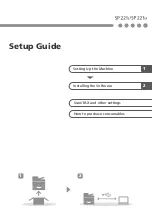
Network Connectivity
Xerox
®
WorkCentre
®
7970 Multifunction Printer
37
System Administrator Guide
5.
Under IP Address Resolution, select an option:
−
STATIC
disables dynamic addressing and allows you to type a static IP address. Type a
Machine IP Address, Subnet Mask, and Gateway Address.
−
DHCP
allows the printer to obtain an IP address from a DHCP server or a BOOTP server that is
configured to accept DHCP requests. The printer requests that the server register the IP address
and hostname of the printer with the DNS server.
−
BOOTP
allows the printer to obtain an IP address from a BOOTP server that does not respond
to DHCP requests.
6.
Under Broadcast, select
Enabled
as needed.
Note:
If the printer does not obtain an IP address from a DHCP/BOOTP server, enable broadcast.
This situation occurs when your DHCP/BOOTP server is on a different subnet than the printer and
communicates through a router acting as a relay agent.
7.
In the Zero-Configuration Networking pane, for Self Assigned Address, select
Enabled
as needed.
This option instructs the printer to assign itself an address when a DHCP server does not provide
one.
8.
Click
Apply
.
Note:
If you select Default All, the printer disables FIPS 140 mode.
Configuring IPv6
IPv6 hosts can automatically configure themselves when connected to a routed IPv6 network using the
Internet Control Message Protocol Version 6 (ICMPv6). ICMPv6 performs error reporting for IP along
with other diagnostic functions. When first connected to a network, a host sends a link-local multicast
router solicitation request for configuration parameters. If suitably configured, routers respond to this
request with a router advertisement packet containing network-layer configuration parameters.
1.
In CentreWare Internet Services, click
Properties
>
Connectivity
>
Setup
.
2.
Under Network, next to a connection type, click
Edit
.
Note:
The printer uses separate IPv4, IPv6, and DNS settings for wired and wireless network
connections. Before configuring wireless IP settings, install the Xerox
®
Wireless Network Interface
and connect to a wireless network. For details, see
Connecting to a Wireless Network
on page 32.
3.
Under Configuration Settings, next to IP, click
Edit
.
4.
To configure IPv6, click
IPv6
.
IPv6 hosts can automatically configure themselves when connected to a routed IPv6 network using the
Internet Control Message Protocol Version 6 (ICMPv6). ICMPv6 performs error reporting for IP along
with other diagnostic functions. When first connected to a network, a host sends a link-local multicast
router solicitation request for configuration parameters. If suitably configured, routers respond to this
request with a router advertisement packet containing network-layer configuration parameters.
CAUTION:
If both IPv4 and IPv6 are disabled, you cannot access CentreWare Internet Services. To
access IPv4 and IPv6 settings in CentreWare Internet Services, enable TCP/IP at the printer control
panel. If you disable TCP/IP or change the IP address, any dependent protocols are disabled.
















































